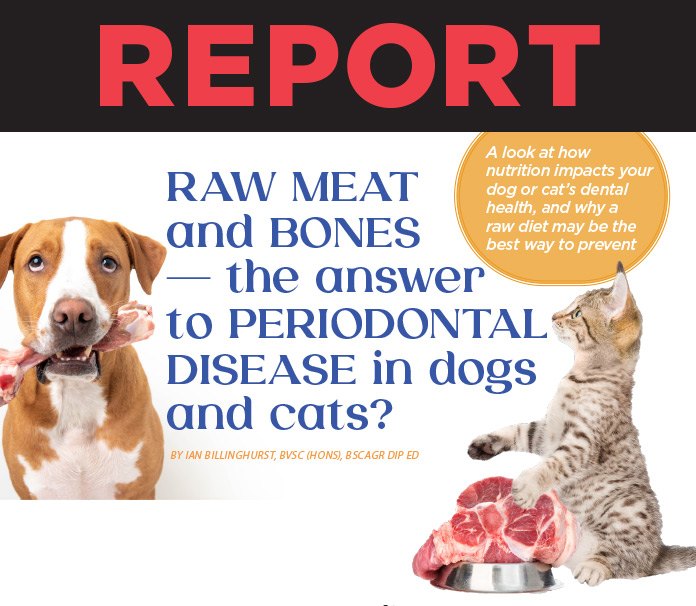If you have a dog or cat with periodontal disease, you’re familiar with the signs. They include bleeding and painful gums; foul breath; tartar covered teeth that loosen and may even come out; and receding gums with pus-filled pockets round the tooth roots. Needless to say, periodontal disease is very unpleasant — and very painful for your dog or cat. On the plus side, maintaining good dental health in your animal companion may be as easy as providing him with a diet of raw meat and bones.
PERIODONTAL DISEASE IS ENDEMIC
Periodontal disease is one of the first degenerative disease processes to afflict today’s domestic cats and dogs; in fact, it often starts before the animals even hit puberty. By the age of five, around 85% of dogs and cats are exhibiting some degree of periodontal disease. This problem is reaching epidemic proportions in the canine and feline population throughout the Western world. And it is also a far more dangerous problem for our furry family members than it is for we humans.
One of the first signs that a dog or cat has periodontal disease is a line of red, inflamed tissue along the gum-line. Unfortunately, this is not something most people notice. Over time, however, particularly when people fail to take suitable preventative measures, the sign of advancing disease become difficult to dismiss. These can include excessive drooling, pawing at the mouth, pain when eating, reluctance to chew, and food dropping from the mouth when eating. Facial swelling, a reluctance to be handled round the head, and even aggression may also occur.
Periodontal disease starts insidiously as simple gingivitis, an inflammation of the gum-line with no damage to the supporting tooth structures. At this stage, basic hygiene measures (teeth cleaning) or even a change in diet may be enough to halt it in its tracks. But left untreated, the problem can become progressive, and to a degree, even irreversible, including actual loss (resorption) of the jawbone itself. Worse yet, periodontal disease can have long-term and debilitating consequences for other parts of the body, including the cardiovascular, respiratory, and immune systems, the kidneys, and less commonly, the reproductive system (the latter is less common only because most dogs and cats are spayed or neutered at a young age). The mouth has become a focus of infection that is quietly and insidiously spreading blood-borne bacterial infections around the body.

SO WHAT’S THE SOLUTION?
Many experts will say that the only way to prevent periodontal disease dogs and cats is by daily cleaning their teeth with a toothbrush and specially-formulated toothpaste. But that isn’t the only answer. In fact, periodontal disease, as bad and as common as it is, does not have to be. It can be prevented, and (to a degree) even reversed and obliterated once established. The clues to the solution lie in some simple epidemiological observations.
When I was a veterinary student in the early to mid-1970s, our lecturers stressed that we wouldn’t see a lot of animals with diseases of the periodontium if we practiced veterinary medicine here in Australia. Should we choose to practice in North America, we would find periodontal disease to be one of the most common problems we would encounter. After graduating as a veterinary surgeon, however, I witnessed a gradual increase in the incidence of periodontal disease in Australia, most particularly in the smaller dog breeds, with the Maltese terrier being a prime example. Now, we Australian vets find that periodontal disease is as common here as it is in the rest of the developed world — in all breeds of dogs and cats. The question is, why? The answer turns out to be deceptively simple. The increased incidence of periodontal disease in Australia parallels the decreased feeding of raw foods and bones in canine and feline populations.
In the 70s, Australian dogs and cats gnawed on raw meaty bones and chunky pieces of raw meat. Tough and abrasive animal tissues had been a constant and normal part of their diets from time immemorial. In contrast, dogs and cats in the US and Canada (in the 70s and today) consume a diet that — for the most part — lacks these simple food items.
WHY RAW FOOD IS SO GOOD FOR DENTAL HEALTH
How do raw meat and bones chart a healthy course for the canine and feline mouth? Their role is multifactorial. It involves optimal immune system functioning; the constant repopulation of the oral cavity with those organisms found in the raw food; the chemical nature of raw food; and the physical cleansing activities of meat, bone, cartilage, and tendons on tooth enamel and gums. In short, raw food creates the optimal conditions for healthy teeth and gums. This explains why the Australian cat and dog population was largely free of periodontal disease in the 1970s; it was because the food they ate fostered oral health. Meanwhile, this type of food was not part of the canine and feline diet in North America.

THE BOTTOM LINE
The solution to periodontal disease in dogs and cats is therefore quite simple – all that’s required is a change in diet. The answer lies in the daily use of nature’s toothbrush — the humble raw, meaty bone with its attached cartilage and tendons, together with large chunks of tough, raw meat. Even if your dog or cat eats a dry or canned diet, the addition of raw food will help keep his teeth and gums healthy. We know this through our comparison of Australian and North American dogs and cats back in the seventies — and because a growing number of people are turning back to this time-honored and effective way to rid their dogs and cats of periodontal disease, with excellent results.
Veterinarian Dr. Ian Billinghurst received his Veterinary Science degree (honors) from Sydney University in Australia in 1976 and has been in companion animal practice since then. He founded the BARF diet concept, and has written several books on animal nutrition, including Give Your Dog a Bone and The BARF Diet. He is working on a range of e-books dealing with raw nutrition for dogs and cats. You can learn more about raw feeding at drianbillinghurst.com.
[su_button url=”https://facebook.com/AnimalWellnessMagazine” target=”blank” style=”flat” background=”#3756a6″ color=”#ffffff” size=”8″ wide=”yes” center=”yes” radius=”0″ text_shadow=”0px 0px 0px #000000″]Visit our Facebook page for more great content![/su_button]









